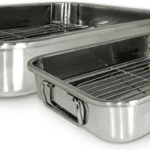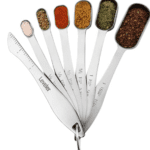Last updated on July 4th, 2024 at 11:31 pm
Learn how to make the best tender and juicy pork loin roast for your next family meal. Ah, the Pork Loin Roast. That glorious centerpiece that graces our dinner tables on special occasions and Sunday feasts alike.
If you’re looking for a delicious pork loin roast recipe that’s tender and juicy, look no further! This recipe is easy to follow and will result in a mouth-watering meal that your family and friends will love.
Whether you’re hosting an intimate dinner or simply craving a mouthwatering treat. Learn about the simple steps that help take a pork roast from mundane to amazing.
No More Dry and Tasteless Roast
Have you ever attempted to cook a pork loin roast only to be met with a dry and lackluster result? Fear not, for we’ve got you covered. We have a great recipe using simple ingredients.
From prepping the roast to infusing it with mouthwatering flavors. It is sure to be the star of your own kitchen.
Get ready to discover the best tender and juicy pork loin roast recipe that will have your friends and family praising your culinary expertise. It’s time to turn a simple cut of meat into a delicious main dish that leaves everyone craving seconds.

Post contains affiliate links, and we earn commissions if you shop through the links on this page. For more information, please read the disclosure section under the About Us page.
Mastering the Art of a Succulent Pork Loin Roast: Your Go-To Recipe Guide
Ready to unlock the secrets? Let’s dive into the heart of this recipe and explore how to achieve that pork perfection you’ve always dreamed of. Your taste buds will thank you and so will your dinner guests.
The Best Cut of Meat for Pork Pot Roast
When it comes to choosing a cut of pork for your roast, there are several options available. Each of the different cuts of meat has its own unique characteristics. There are so many popular cuts available in the grocery store. Let’s highlight a few popular cuts that are commonly used for roasting:
Learner Cuts of Meat
Pork Loin Roast: This is often considered one of the best cuts for roasting due to its tenderness and versatility. The pork loin is located along the back of the pig and is relatively lean. It can be boneless or bone-in, and it’s known for its mild flavor. Pork loin roasts are great for showcasing various seasonings and herbs. They are also relatively easy to carve and can yield tender, juicy results when cooked properly.
Pork Tenderloin: This is the leanest cut of pork and is often considered the filet mignon of pork. Pork tenderloin is elongated and cylindrical in shape, making it perfect for slicing into medallions. It cooks quickly and can become dry if overcooked, so it’s essential to monitor the internal temperature closely. Due to its lean nature, marinating or wrapping it in bacon can help maintain moisture.
Fattier Cuts of Meat
Pork Shoulder Roast (Boston Butt): The pork shoulder is a more flavorful and slightly fattier cut. It’s well-suited for slow cooker roasting, which allows the connective tissues to break down, resulting in tender, succulent meat. Boston Butt is a specific cut from the pork shoulder that is commonly used for pulled pork. It has more marbling, which contributes to its rich flavor and moisture.
Pork Rib Roast: Also known as the rack of pork, this cut includes the rib bones and loin meat. It’s a visually impressive cut that’s excellent for a special occasion. The ribs add flavor and can serve as a natural roasting rack. Keep in mind that the meat along the bones can be slightly fattier and more flavorful.
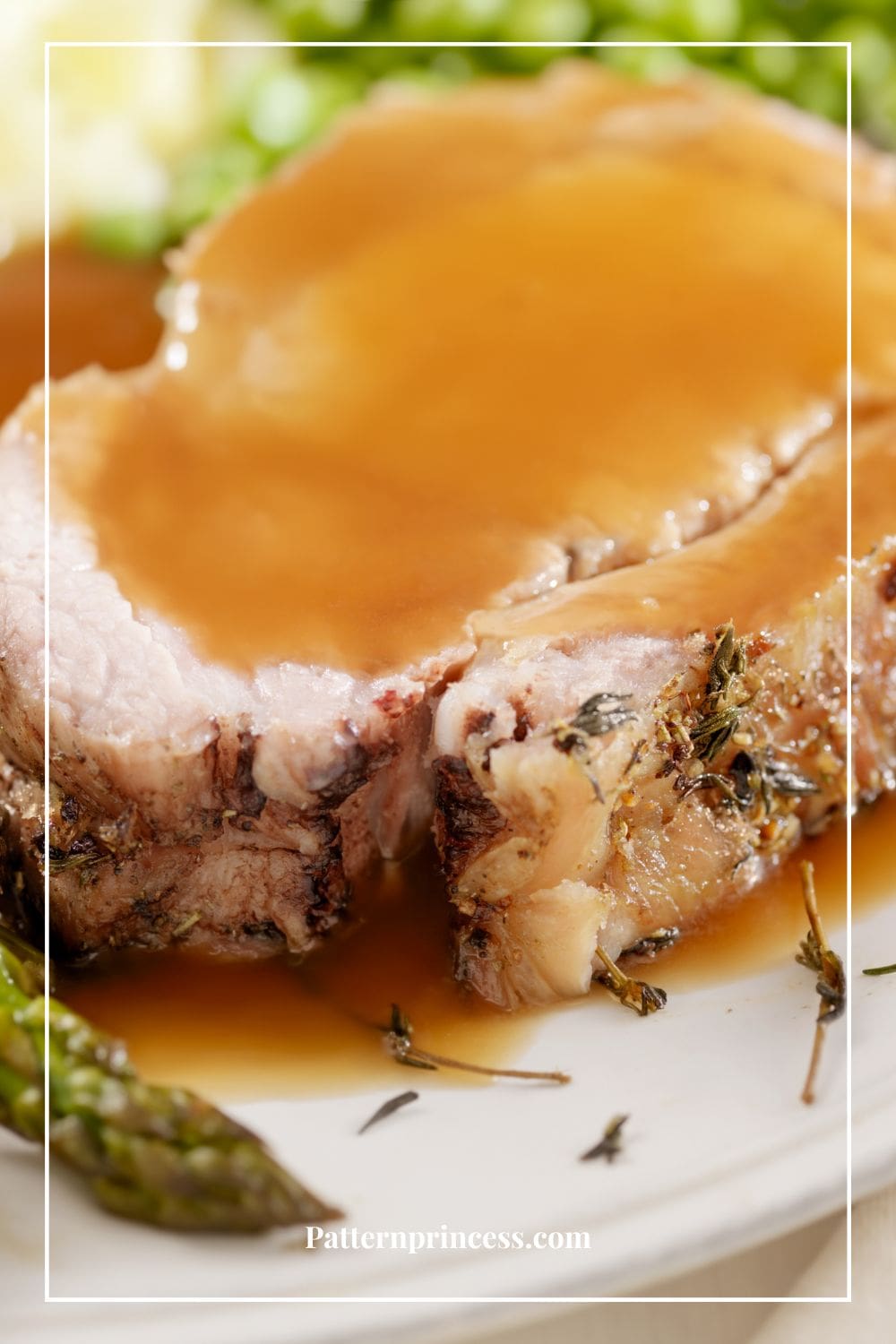
Which one is The Better Choice: It Depends on Your Preferences
The “better” choice among these cuts really depends on your preferences, the occasion, and your desired flavors. If you’re aiming for tenderness and a milder taste, a boneless pork loin roast might be your go-to. If you’re looking for deep, rich flavor and a more rustic dish, the pork shoulder or Boston Butt could be ideal.
Additionally, consider the cooking method. Some cuts, like the pork shoulder, benefit from slow roasting at lower temperatures to achieve that fall-apart tenderness, while others, like the pork loin, are better suited for quicker roasting.
Always pay attention to the marbling (fat distribution) in the meat. While lean cuts can be delicious and healthy, a bit of fat can contribute to flavor and moisture.
In the end, the best choice is the one that aligns with your tastes, cooking skills, and the experience you want to create. Experimenting with different cuts and techniques can lead to discovering your personal favorite for a perfect, tender, and juicy pork roast.
Fresh Herbs vs. Dry Herbs: The Flavor Showdown
The choice between fresh herbs and dried herbs can significantly impact the final result. Each type brings its own set of qualities to the table, and understanding their differences will help you make an informed decision.
Fresh Herbs of course are bursting with freshness
Fresh herbs, like the rosemary and thyme called for in the recipe, are a direct invitation to nature’s bounty. They offer an unmatched burst of flavor and fragrance, elevating your dish to a whole new level. When you chop these aromatic wonders and rub them onto your pork roast, you’re essentially infusing it with their vibrant oils, releasing an enticing aroma as they roast.
Fresh herbs are especially fantastic if you have them on hand or growing in your garden. They provide an authentic touch to your cooking, making the dish feel even more homemade and gourmet.
However, there are a few things to consider when opting for fresh herbs:
Quantity: Fresh herbs are generally less potent than their dried counterparts. This means you might need to use more to achieve the desired flavor profile.
Timing: Since they’re water-rich, fresh herbs can burn easily during the roasting process. To prevent this, they are often added toward the end of cooking or used as a rub, like in our recipe.
Dried Herbs: Concentrated Flavors
Dried herbs, on the other hand, offer a more concentrated flavor punch. They are essentially the fresher counterparts with most of the moisture removed. This makes them great for long cooking processes like roasting, as they release their flavors gradually, infusing the dish over time.
Using dried herbs can be particularly convenient, especially when fresh herbs are not in season or readily available.
Here are a few things to keep in mind:
Quantity: Dried herbs are more potent than fresh herbs, so you’ll need less of them to achieve the same flavor impact as fresh. A general rule of thumb is to use about one-third the amount of dried herbs compared to fresh.
Timing: Since dried herbs take longer to release their flavors, they’re usually added earlier in the cooking process, allowing them to mingle and enhance the overall taste.
Personal Preference and Flexibility
The choice between fresh and dried herbs largely depends on personal preference and what you have on hand.
Both options can yield incredible results. Fresh herbs bring that “just picked” vibrancy, while dried herbs offer a concentrated, consistent flavor.
In the end, it’s about what aligns with your cooking style and the flavors you want to achieve. So, whether you’re snipping fresh rosemary from your herb garden or reaching for that trusty jar of dried thyme, the journey toward a tender and juicy pork loin roast is yours to tailor.
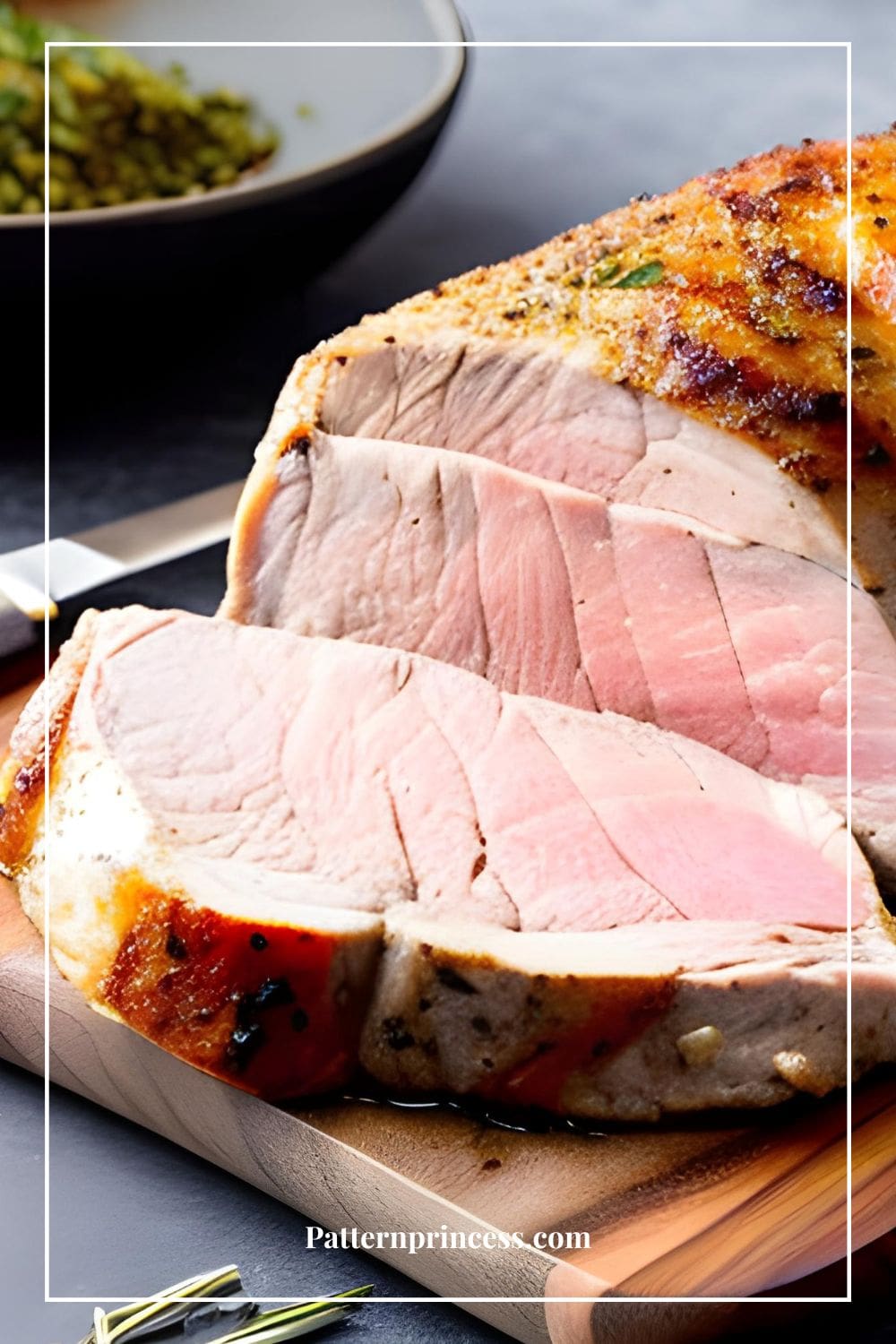
Easy Steps with Restaurant Quality Results with This Pork Tenderloin Recipe
To start, preheat your oven to 350°F. Then, in a small bowl, mix together 2 tablespoons of olive oil, 2 teaspoons of minced garlic, 1 teaspoon of dried thyme, 1 teaspoon of dried rosemary, and 1 teaspoon of salt. Rub this mixture all over the pork loin roast, making sure to coat it evenly.
Place the pork loin roast in a roasting pan and add 1 cup of chicken broth to the pan. Roast in the oven for 1 to 1 1/2 hours, or until the internal temperature reaches 145°F.
Let the roast rest for 10 minutes before slicing and serving. This recipe is sure to impress your guests and become a family favorite.
Tips for Recipe Success
Bringing the pork loin roast to room temperature before cooking helps it cook more evenly.
Use a meat thermometer to ensure that the internal temperature reaches 145°F (63°C) for optimal doneness.
Letting the roast rest after cooking allows the juices to redistribute, resulting in a juicier roast.
For the best results and extra flavor, consider marinating the pork loin roast with the herb mixture in the refrigerator for a few hours before cooking.
If you prefer a less pink interior, you can cook the roast to a slightly higher internal temperature, but be cautious not to overcook it, as it can become dry.
You can bake this roast in a Dutch oven and add root vegetables for a whole meal using just one pot.
Recipe Options
If you prefer a sweet base to your pork spice rub, add some brown sugar to the rub mix. Just 2 tablespoons seems to do it.
Another great option is to add 1 tablespoon of garlic powder, soy sauce, and yellow mustard easy to the pan juices for an added kick of flavor when making the gravy.
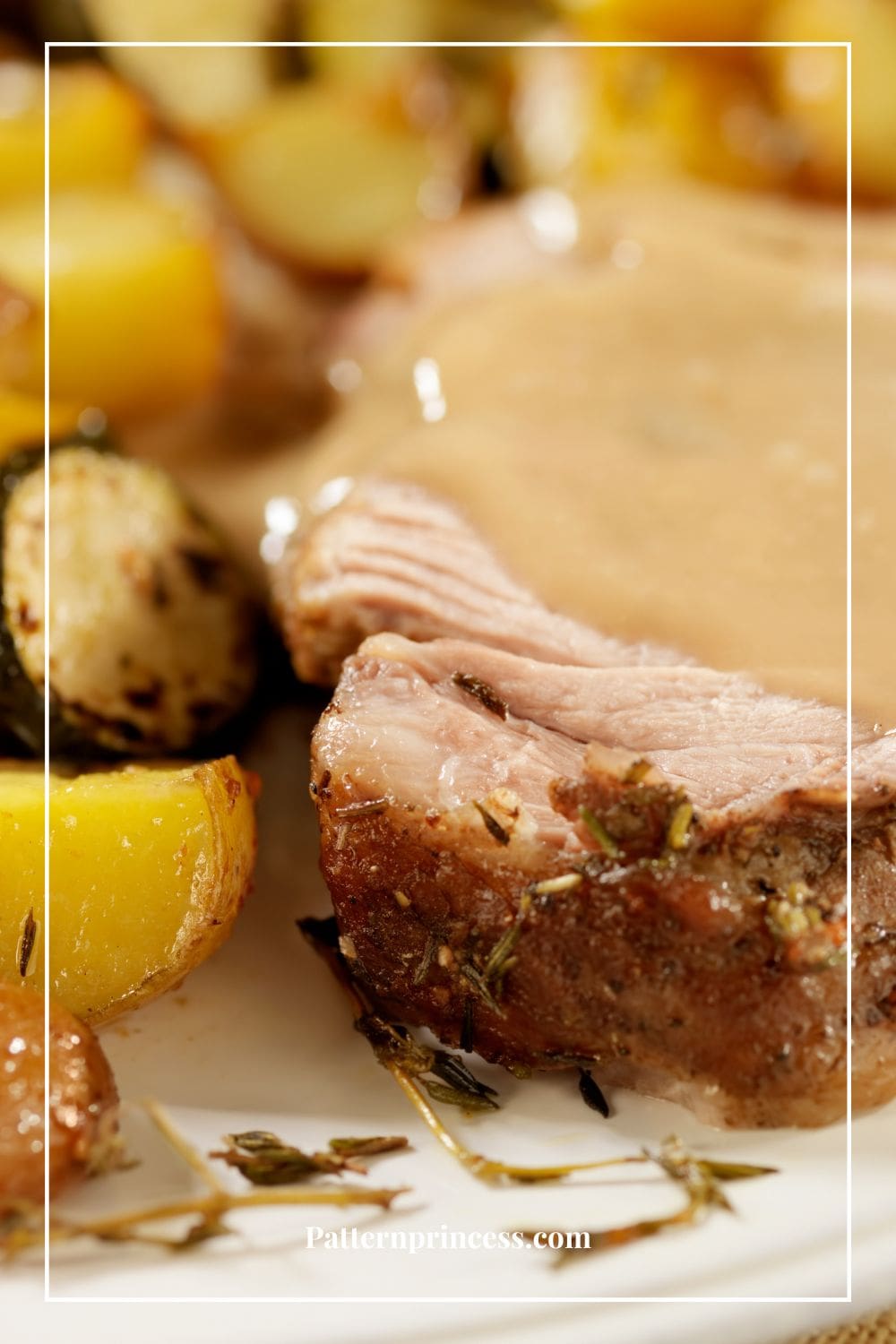
Pork Loin Marinade Recipe
Here’s a flavorful marinade you can use to enhance the taste of your pork loin roast:
Herb and Citrus Marinade for Pork Loin Roast:
Ingredients:
- 1/4 cup olive oil
- 1/4 cup orange juice
- 2 tablespoons lemon juice
- 2 cloves garlic, minced
- 1 tablespoon fresh rosemary, chopped
- 1 tablespoon fresh thyme, chopped
- 1 teaspoon dried oregano
- 1 teaspoon dried basil
- 1 teaspoon salt
- 1/2 teaspoon black pepper
Instructions:
Mixing the Marinade:
In a bowl, whisk together the olive oil, orange juice, lemon juice, minced garlic, chopped rosemary, chopped thyme, dried oregano, dried basil, salt, and black pepper until well combined.
Marinating the Pork:
Place the pork loin roast in a resealable plastic bag or a shallow dish.
Pour the marinade over the pork, ensuring that the roast is evenly coated. Massage the marinade into the meat to make sure it’s well distributed.
Seal the bag or cover the dish with plastic wrap and refrigerate for at least 4 hours, or ideally overnight. Turn the pork occasionally to marinate all sides evenly.
Cooking the Pork:
When you’re ready to cook the pork, remove it from the marinade and pat it dry with paper towels. Discard the marinade.
Following the Original Recipe:
Proceed with the original recipe I provided earlier for searing, roasting, resting, and making the gravy.
This marinade adds a citrusy and herby kick to your pork loin roast, enhancing its natural flavors. Remember to adjust the cooking time slightly if the roast has been marinating for an extended period, as the acidity in the marinade can slightly tenderize the meat.
Enjoy your succulent and flavorful pork loin roast.

What to Serve with Pork Loin Roast Recipe?
A succulent pork roast deserves equally delightful accompaniments to create a well-rounded and satisfying meal for your family dinner. Here are some ideas for side dishes that will complement the flavors of your tender and juicy pork loin roast:
Creamy mashed potatoes are a classic pairing with roast pork. Their velvety texture and buttery flavor provide a comforting contrast to the meat’s savory notes.
Roast a medley of seasonal vegetables, such as green beans, carrots, Brussels sprouts, and butternut squash, with olive oil, garlic, and herbs. The caramelized flavors will harmonize beautifully with the pork.
Green Beans Almondine. Lightly blanched green beans sautéed with toasted almonds and a touch of lemon juice offer a refreshing and crunchy side that complements the richness of the pork.
Apple Sauce. The natural sweetness of apple sauce pairs wonderfully with pork. Its tangy and fruity profile can cut through the richness of the meat, creating a harmonious balance.
Potatoes. For a different take on potatoes, try roasting them until they’re crispy on the outside and fluffy on the inside. Sprinkle with rosemary or thyme for an extra layer of flavor.
Delicious Homemade Sides
Sweet Potatoes. Whether baked in the oven or made into a casserole, they are the perfect pairing with a homemade pork roast.
Creamed Spinach. A creamy, savory spinach dish adds color and nutrition to your plate while providing a velvety texture that contrasts nicely with the roast.
Caesar salad. A fresh salad with fresh garlic, anchovy, buttermilk, mayonnaise, Dijon mustard, Worcestershire sauce, lemon juice, red wine vinegar, fresh parmesan cheese, salt and black pepper. Can bring a delightful balance of flavors and textures to your meal.
Wild Rice Pilaf. A nutty and aromatic wild rice pilaf can add depth to your meal. Include sautéed onions, garlic, and fresh herbs to elevate the flavors.
Gravy. Use the pan drippings from your roast to create a rich and flavorful gravy. Drizzle it over the pork and sides to tie everything together.
Dinner Rolls. Warm, freshly baked dinner rolls or crusty bread can complete the meal, providing a satisfying element for soaking up any delicious sauces or juices.
Whether you’re aiming for a cozy winter feast or a vibrant summer spread, these side dish ideas will help you create a delicious dining experience alongside your tender and juicy pork loin roast.
How to Store Leftovers and Reheat?
Properly storing leftovers and reheating them is essential to maintain the quality and safety of your food. Here’s how to store and reheat your leftover pork loin roast and side dishes:
Storing Leftovers
Once the pork roast has cooled to room temperature, slice any remaining meat from the roast and store it in an airtight container or resealable plastic bag. If you have bone-in roast leftovers, remove the bones and store the meat separately. This helps prevent moisture from being trapped, which can lead to sogginess.
Just like restaurants. At home, you should make sure to label your containers with the date you cooked the roast and side dishes. Leftovers are best consumed within 3-4 days.
Reheating Leftovers
When reheating sliced pork loin roast, it’s best to avoid further cooking that might dry out the meat. Instead, gently warm the slices in the microwave using short intervals or in a covered oven-safe dish at a low temperature (around 250°F or 120°C). Adding a splash of broth or gravy can help maintain moisture.
General Reheating Tips
Stir and distribute the heat evenly while reheating to avoid cold spots or overheating in the center.
To prevent dryness, consider adding a bit of liquid like broth, gravy, or water to your reheating container.
Covering the container with a lid or microwave-safe wrap can help retain moisture.
If you have a large quantity of leftovers, it’s better to reheat in smaller batches to ensure even heating.
Best Tender and Juicy Pork Loin Roast Recipe
As an Amazon Associate I earn from qualifying purchases.
Kitchen Essentials
Ingredients
- 5 Pounds Boneless Pork Loin Roast
- 3 Cloves Garlic minced
- 2 Tablespoons Rosemary Fresh and chopped
- 2 Tablespoons Thyme Fresh and chopped
- 2 Tablespoons Olive Oil
- Salt to taste
- Black Pepper to taste
Gravy
- 1 Cup Chicken or vegetable broth
- 1/2 Cup White Wine or additional broth
- 2 Tablespoons Butter
- 2 Tablespoons All-purpose Flour
text ingredients
Instructions
- Preheat your oven to 375°F (190°C).
- Remove the pork loin roast from the refrigerator and let it come to room temperature for about 30 minutes. This ensures even cooking.5 Pounds Boneless Pork Loin Roast
- In a small bowl, combine the minced garlic, chopped rosemary, chopped thyme, olive oil, salt, and black pepper. Mix well to create a paste.3 Cloves Garlic, 2 Tablespoons Rosemary, 2 Tablespoons Thyme, Salt, Black Pepper
- Pat the pork loin roast dry with paper towels. Rub the herb paste all over the surface of the roast, ensuring even coverage.
- Heat a large oven-safe skillet or roasting pan over medium-high heat. Once hot, add a tablespoon of olive oil.2 Tablespoons Olive Oil
- Sear the pork loin roast on all sides until nicely browned, about 2-3 minutes per side.
- Place the seared pork loin roast in the preheated oven. Roast for about 50-60 minutes, or until the internal temperature reaches 145°F (63°C) for medium doneness. Use a meat thermometer inserted into the thickest part of the roast to check the temperature.
- Once the pork reaches the desired temperature, remove it from the oven and transfer it to a cutting board. Tent it loosely with aluminum foil and let it rest for about 10-15 minutes. This allows the juices to redistribute and the roast to continue cooking slightly.
- Gravy
- While the roast is resting, prepare the gravy. In the same skillet or roasting pan used to sear the pork, melt the butter over medium heat.2 Tablespoons Butter
- Add the flour and whisk continuously to create a roux. Cook for a few minutes until the roux is golden brown.2 Tablespoons All-purpose Flour
- Gradually pour in the chicken or vegetable broth and white wine while whisking constantly. Continue to cook and whisk until the gravy thickens. Season with salt and pepper to taste.1 Cup Chicken, 1/2 Cup White Wine
- Slicing and Serving:
- Slice the rested pork loin roast into even slices. Serve the slices drizzled with the prepared gravy.
Your Own Private Notes
Notes
Tips for Recipe Success
If using dried herbs, use 1 tablespoon of dried thyme and dried rosemary. Bringing the pork loin roast to room temperature before cooking helps it cook more evenly. Use a meat thermometer to ensure that the internal temperature reaches 145°F (63°C) for optimal doneness. Letting the roast rest after cooking allows the juices to redistribute, resulting in a juicier roast. For the best results and extra flavor, consider marinating the pork loin roast with the herb mixture in the refrigerator for a few hours before cooking.If you prefer a less pink interior, you can cook the roast to a slightly higher internal temperature, but be cautious not to overcook it, as it can become dry.
You can bake this roast in a Dutch oven and add root vegetables for a whole meal using just one pot.
Nutrition
A few of my favorite things
The Power of Positivity

You can find Victoria crocheting, quilting, and creating recipes. She has cooked in restaurants for over 20 years, including many larger parties. She learned to crochet when she was just 11 years old and has been crocheting ever since; over 50 years now. Over 40 years ago, she loved her first class in sewing and continues to hone her skills in quilting. Many have enjoyed the handmade gifts over the years. In her professional career, she has worked in management in a wide variety of businesses including higher education as a dean of a division. All the while attending college part-time to achieve her doctorate in higher education with an emphasis in e-learning.



